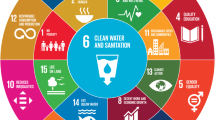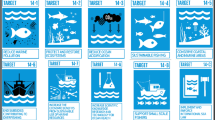Abstract
Monitoring national-level progress of Sustainable Development Goal (SDG) 6 through internationally agreed indicators has been the focus of intense scrutiny and considerable resourcing by international organisations and national governments, suggesting a ‘race for indicators’ has begun. However, in the eyes of many water experts, SDG 6 indicators are far from perfect. It is important to systematically identify and prioritise the gaps and weaknesses in the SDG 6 indicator framework to address them effectively. This paper identifies two potential gaps: first, between the aspirations captured in SDG 6 targets and what will be measured by the relevant indicators; and second, between what is being measured in ‘means of implementation’ indicators and what the key means of implementation achievements of many countries are expected to be under SDG 6. Three existing mechanisms—complementary indicators, international support and an integrated approach—are briefly described, and it is proposed that they may potentially be harnessed to assist national governments to address the two types of gaps identified for SDG 6. There is also an opportunity for stakeholders to help erase the gaps in a comprehensive review of SDG indicators, though how open and participatory the full review process will be is not yet clear.

Source: adapted by authors from UN-Water 2015
Similar content being viewed by others
Notes
See sustainabledevelopment.un.org/hlpf.
Tier I indicators have an established methodology and standards, and data are regularly produced by countries; tier II indicators have an established methodology and standards, but data are not regularly produced by countries and tier III indicators lack established methodology and standards (see unstats.un.org/sdgs/iaeg-sdgs/tier-classification/for definitions and www.unwater.org/publications/sdg-6-indicators-tiering-system/ for up to date tier classifications for SDG 6).
with nine indicators repeated under two or three different targets, there is a current total of 244.
UN-Water Inventory, 15 January 2018, used with permission from UN-Water.
References
ASCE (American Society of Civil Engineers) (2011) Failure to Act: the economic impact of current investment trends in water and wastewater treatment infrastructure. Boston
Bartram J, Brocklehurst C, Bradley D, Muller M, Evans B (2018) Policy review of the means of implementation targets and indicators for the sustainable development goal for water and sanitation. npj Clean Water. https://doi.org/10.1038/s41545-018-0003-0
Bhaduri A, Bogardi J, Siddiqi A, Voigt H, Vörösmarty C, Pahl-Wostl C, Bunn SE, Shrivastava P, Lawford R, Foster S, Kremer H, Renaud FG, Bruns A, Osuna VR (2016) Achieving Sustainable Development Goals from a Water Perspective. Front Environ Sci. https://doi.org/10.3389/fenvs.2016.00064 (Article 64)
Canadian Council for International Co-operation (2017) Progressing National SDGs Implementation: an independent assessment. Canadian Council for International Co-operation, Ottawa
Donald K, Way S (2016) Accountability for the sustainable development goals: a lost opportunity? Ethics Int Aff 30:201–213
Elder M, Bengtsson M, Akenji L (2016) An optimistic analysis of the means of implementation for sustainable development goals: thinking about goals as means. Sustain. https://doi.org/10.3390/su8090962
Fisher MB, Shields KF, Chan TU, Christenson E, Cronk RD, Leker H, Samani D, Apoya P, Lutz A, Bartram J (2015) Understanding handpump sustainability: determinants of rural water source functionality in the greater Afram Plains region of Ghana. Water Resour Res 51:8431–8449
Flores Baquero O, Gallego-Ayala J, Giné-Garriga R, Fernández Jiménez, de Palencia A, Pérez-Foguet A (2017) The influence of the human rights to water and sanitation normative content in measuring the level of service. Soc Indic Res 133:763–786. https://doi.org/10.1007/s11205-016-1374-6
Guppy L (2014) The Water Poverty Index in rural Cambodia and Viet Nam: a holistic snapshot to improve water management planning. Nat Resour Forum 38:203–219. https://doi.org/10.1111/1477-8947.12051
Harlin J, Kjellen M (2015) Water and development: from MDGs towards SDGs. In: Jägerskog A, Clausen TJ, Holmgren T, Lexén K (eds) Water for development—charting a water wise path, SIWI report no. 35, Stockholm, pp. 8–14
Heller L (2017) Open Letter from the United Nations Special Rapporteur on the human rights to safe drinking water and sanitation, Mr. Léo Heller, to the WHO-UNICEF Joint Monitoring Programme for WASH. United Nations Off. High Comm. SPB/SHD/AL
Hering JG (2017) Managing the “monitoring imperative” in the context of SDG target 6.3 on water quality and wastewater. Sustain 9:1–8. https://doi.org/10.3390/su9091572
King M (2016) Broadening the global development dramework post 2015: embracing policy coherence and global public goods. Eur J Dev Res 28:13–29. https://doi.org/10.1057/ejdr.2015.75
Martel P (2016) Review of options for reporting water, sanitation and hygiene coverage by wealth quintile, MICS Methodological Papers, No.4, Data and Analytics Section, Division of Data, Resarch and Policy, UNICEF New York
Nilsson M, Griggs D, Visback M (2016a) Map the interactions between sustainable development goals. Nature 534:320–322. https://doi.org/10.1038/534320a
Nilsson M, Griggs D, Visbeck M, Ringler C (2016b) A draft framework for understanding SDG interactions. International Council for Science (ICSU), Paris
Rouse M (2014) The worldwide urban water and wastewater infrastructure challenge. Int J Water Resour Dev 30:20–27. https://doi.org/10.1080/07900627.2014.882203
Rural Water Supply Network (2010) Myths of the rural water supply sector. RWSN perspectives no. 4
Sustainable Development Solutions Network (2015) Indicators and a monitoring framework for the sustainable development goals: launching a data revolution. A report to the secretary-general of the United Nations by the leadership council of the sustainable development solutions network
Thomson P, Koehler J (2016) Performance-oriented monitoring for the water SDG—challenges, tensions and opportunities. Aquat Proc 6:87–95. https://doi.org/10.1016/j.aqpro.2016.06.010
United Nations (2010) The human right to water and sanitation. UN general assembly resolution A/RES/64/2. United Nations, New York
United Nations (2015) Transforming our World: the 2030 agenda for sustainable development. UN general assembly resolution A/RES/70/1. United Nations, New York
United Nations (2016a) Global sustainable development report, 2016th edn. United Nations, New York
United Nations (2016b) Progress towards the sustainable development goals: report of the secretary-general. In: United Nations Econ. Soc. Counc. E/2016/75: Agenda items 5, 6 and 18 (a)
United Nations (2017) Report of the inter-agency and expert group on sustainable development goal indicators note by the secretary-general. Statistical commission forty-eighth session, item 3 (a) of the provisional agenda. E/CN.3/2017/2*, New York
United Nations (2018) Sustainable development goal 6 synthesis report 2018 on water and sanitation. UN Water, Geneva
United Nations Statistics Division (2017a) SDG indicators metadata repository: 6.1. https://unstats.un.org/sdgs/metadata/
United Nations Statistics Division (2017b) SDG indicators metadata repository: 6.2. https://unstats.un.org/sdgs/metadata/
United Nations Technical Support Team (2014) Technical support team (TST) issues briefs. Inter-agency technical support team for the United Nations General Assembly Open Working Group on Sustainable Development Goals, New York
UNSGAB (United Nations Secretary-General’s Advisory Board on Water & Sanitation) (2015) The UNSGAB journey. UNSGAB, New York
UN-Water (2015) Means of implementation : a focus on sustainable development goals 6 and 17. UN-Water, Geneva
UN-Water (2016a) Integrated monitoring guide for SDG 6: targets and global indicators. UN-Water, Geneva
UN-Water (2016b) Metadata on suggested indicators for global monitoring of the sustainable development goal 6 on water and sanitation, version 1. UN-Water, Geneva
UN-Water (2016c) Water and sanitation interlinkages across the 2030 agenda for sustainable development. UN-Water, Geneva
UN-Water (2017) Methodological note: indicators and proposed monitoring framework for means of implementation (MoI) targets for sustainable development goal 6-DRAFT. UN-Water, Geneva
WHO (2017) Guidelines for Drinking water Quality: fourth edition incorporating the first addendum. World Health Organisation, Geneva
WHO and UNICEF (2006) Core questions on drinking-water. WHO and UNICEF, Geneva
WHO and UNICEF (2016) WASH in the 2030 Agenda. WHO and UNICEF, Geneva
WHO and UNICEF (2017a) Progress on drinking water, sanitation and hygiene: 2017 update and SDG baselines—Annexes. WHO and UNICEF, Geneva
WHO and UNICEF (2017b) Progress on drinking water, sanitation and hygiene: 2017 update and SDG baselines. WHO and UNICEF, Geneva
WHO and UNICEF (2017c) Safely managed drinking water—thematic report on drinking water 2017. WHO and UNICEF, Geneva
WHO and UNICEF (2017d) Guidance note to facilitate country consultation on JMP estimates for drinking water, sanitation and hygiene. WHO and UNICEF, Geneva
Acknowledgements
The United Nations University Institute for Water, Environment and Health (UNU-INWEH) is funded by the Government of Canada. The SDG Policy Support System mentioned was developed in partnership by UNU-INWEH, the United Nations Office for Sustainable Development, the Korea Environment Corporation (Keco) and the Ministry of Environment, Republic of Korea.
Author information
Authors and Affiliations
Corresponding author
Additional information
Handled by Sharachchandra Lele, Ashoka Trust for Research in Ecology and the Environment, India.
Rights and permissions
About this article
Cite this article
Guppy, L., Mehta, P. & Qadir, M. Sustainable development goal 6: two gaps in the race for indicators. Sustain Sci 14, 501–513 (2019). https://doi.org/10.1007/s11625-018-0649-z
Received:
Accepted:
Published:
Issue Date:
DOI: https://doi.org/10.1007/s11625-018-0649-z




